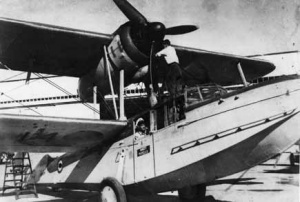Supermarine Type 309 Sea Otter
| Type |
Carrier-borne air-sea rescue amphibian |
|---|---|
| Manufacturer |
Saunders-Roe Ltd, Isle of Wight, UK |
| Number Ordered |
3 |
| First Delivered |
1948 |
| Length |
39 feet 10 inches |
| Height |
16 feet 2 inches |
| Weights | 6740 |
| Dimensions | Wing span: 46 feet |
| Speed | 154 mph |
| Range |
837 miles |
| Crew |
3-4 |
| Engines | One Bristol Mercury XXX radial of 855 bhp |
| Performance | Ceiling: 13,500 feet |
| Ships embarked in |
 The Sea Otter was a long range maritime patrol sea plane (amphibian) produced by Vickers Armstrong (Aircraft) Ltd, formerly Supermarine Aviation Works (Vickers) Ltd, who produced the renowned Spitfire fighter aircraft.
The Sea Otter was a long range maritime patrol sea plane (amphibian) produced by Vickers Armstrong (Aircraft) Ltd, formerly Supermarine Aviation Works (Vickers) Ltd, who produced the renowned Spitfire fighter aircraft.
Supermarine produced a number of sea planes including the bi-plane Seagull V (Walrus) which commenced production in 1936 and 740 were produced up until 1944. The Sea Otter (originally call the Sting Ray) was also a bi-plane and a longer range version of the Walrus. The main difference between the Walrus and the Sea Otter was in the mounting of the engine. The Walrus had a rear-facing engine with pusher propeller and the Sea Otter's engine (normally a 855 horse power Bristol Mercury XXX) was mounted on the upper wing, facing forward with a ‘tractor’ or puller propeller. Production of the Sea Otter commenced in early 1942 and 292 were built and operated by the RAF and Royal Navy (RN). Nine RAF and 21 RN Squadrons were equipped with the Sea Otter which operated extensively in the Atlantic and Mediterranean.
As an amphibian the aircraft could land and take off from both land based runways and from the sea and had a range of 700 miles. The original Sea Otter Mk I was used primarily in the reconnaissance and communications role while the Sea Otter Mk II was a dedicated Search and Rescue (SAR) platform. The Sea Otter had a crew of three/four with the cockpit seated aft of a nosecone assembly. The front and sides of the cockpit were lined with Perspex windows to allow better observation for the crew. The biplane wing arrangement consisted of a lower unit fitted to the roof of the fuselage and an upper unit suspended high over the fuselage. In British service the Sea Otter was armed with a single 7.7mm Vickers K machine gun fitted to the nose and two 7.7mm Vickers K machine guns installed in the aft section of the aircraft. It could also carry 4 x 250 lb bombs.
The RAN acquired three Sea Otters in 1948 for use as carrier borne air-sea rescue aircraft and operated by 723 Squadron. They were embarked in the aircraft carriers HMA Ships Sydney and Vengeance, but with the increased usage of helicopters for air-sea rescue duties they were sold in 1953 and replaced by the Sycamore helicopter.




